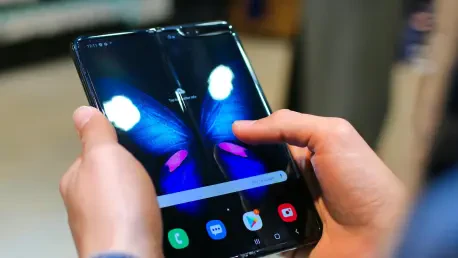I’m thrilled to sit down with Vladislav Zaimov, a seasoned telecommunications specialist whose expertise in enterprise telecommunications and risk management of vulnerable networks offers a unique perspective on the rapidly evolving mobile technology landscape. Today, we’re diving into the dynamic world of foldable smartphones, exploring the factors fueling their recent growth, the challenges they face in capturing a broader market, and the innovations and strategies that could shape their future. From market trends to consumer perceptions and competitive shifts, Vladislav will shed light on what’s driving this niche yet promising segment of the smartphone industry.
How do you explain the impressive 45% year-over-year growth in foldable smartphone shipments during Q2?
That 45% growth is a clear sign that foldables are gaining traction, even if they’re still a small slice of the overall market. A big part of this surge comes from strong demand in key regions like China and the US. In China, we’re seeing a robust appetite for premium devices, while in the US, specific models have really resonated with consumers. Motorola’s latest Razr 60 series, for instance, has been a game-changer with its clamshell design and competitive pricing. Beyond that, manufacturers are stepping up with better designs and features, which is slowly but surely pulling more people into the foldable camp.
What’s holding foldables back from becoming more mainstream, given they only account for 1.5% of the smartphone market?
It’s true that foldables are still a niche. The biggest hurdle is perception—many consumers worry about durability, like how the hinge or screen might hold up over time. Usability is another concern; some folks find the form factor less intuitive compared to traditional slabs. Then there’s the price point—foldables often cost a premium, which can be a tough sell when standard smartphones already do so much. Until these issues are addressed more convincingly, foldables will struggle to break out of that niche status.
A recent survey showed that 64% of people aren’t interested in buying a foldable phone in the next year. Why do you think there’s so much hesitation?
I’m not surprised by that figure. A lot of the hesitation comes down to unfamiliarity—foldables are still new to many, and people tend to stick with what they know works. Durability concerns play a huge role; no one wants to spend a fortune on a device they fear might break easily. There’s also a learning curve with the design—some users aren’t sure how a foldable fits into their daily routine. On top of that, the high cost doesn’t help when most people feel their current phone is good enough. It’s a mix of skepticism and practicality.
What steps could manufacturers take to shift consumer perceptions and boost interest in foldables?
Manufacturers need to focus on education and accessibility. Showcasing real-world durability through stress tests or extended warranties could ease concerns about fragility. They should also highlight practical use cases—demonstrating how foldables enhance productivity or entertainment in ways regular phones can’t. Pricing strategies are key too; offering more affordable entry-level models or financing options could lower the barrier to entry. Finally, continued innovation in design and features, like seamless software integration, can make foldables feel indispensable rather than gimmicky.
Samsung’s Galaxy Fold7 is 48% thinner than its first model. How significant are these kinds of advancements for the foldable market?
Advancements like the Fold7’s slimmer profile are huge. They address one of the early criticisms of foldables—that they’re bulky and cumbersome. A thinner, lighter device feels more like a traditional smartphone, which makes it easier for consumers to adopt. It’s not just about aesthetics; it signals that manufacturers are solving engineering challenges, which builds trust. Features like improved battery life, better cameras, and AI enhancements also show that foldables aren’t just a novelty—they’re becoming competitive with flagship devices in every way.
Mobile carriers are rolling out big promotions for devices like the Galaxy Fold7, with discounts up to $1,100 or even free devices with trade-ins. How are these deals impacting the foldable segment?
These promotions are a massive boost for foldables. They tackle the price barrier head-on, making these devices accessible to a wider audience who might have otherwise balked at the cost. When you can get a cutting-edge foldable for free or at a steep discount with a trade-in, it lowers the risk for curious buyers to take the plunge. This strategy not only drives sales but also gets more foldables into people’s hands, which can create buzz and normalize the form factor over time.
Motorola’s market share in foldables jumped from 14% to 28% in Q2. What’s fueling their surge in this space?
Motorola’s rise is largely thanks to their Razr 60 series. They’ve nailed the nostalgia factor with the clamshell design, which resonates with a lot of consumers, especially in the US. More importantly, their pricing strategy—offering a base model at just $699—has been a knockout. That’s significantly lower than many competitors, making foldables feel more attainable. Add in their focus on integrating AI and powerful chipsets, and Motorola is positioning itself as a serious player that balances affordability with innovation.
What’s your forecast for the future of the foldable smartphone market over the next few years?
I’m optimistic about foldables, but their growth will depend on a few key factors. I expect we’ll see continued innovation—thinner designs, tougher screens, and more seamless software experiences. If manufacturers can keep pushing prices down while maintaining quality, we could see foldables climb beyond that 1.5% market share, maybe even reaching 5-10% in the next three to five years. Competition will heat up, especially with players like Motorola and Huawei gaining ground, which should drive more consumer-friendly options. Ultimately, foldables have the potential to become a significant segment, but only if they can fully win over skeptics with durability and value.









